- 1Graduate School of Science, Kyoto University, Kyoto, Japan
- 2Institute for Space-Earth Environmental Research, Nagoya University, Nagoya, Japan
- 3Institute for Advanced Research, Nagoya University, Nagoya, Japan
- 4Space Physics and Operations Division, RAL Space, Science and Technology Facilities Council, Rutherford Appleton Laboratory, Harwell Oxford, Didcot, United Kingdom
- 5Research Institute for Sustainable Humanosphere, Kyoto University, Uji, Japan
The solar activity has been significantly weakened during the Maunder Minimum (MM: 1645–1715), whereas it has been somewhat controversial to reconstruct the actual solar-activity magnitude and the space weather activity in this interval. Here, the East Asian records provide unique references for the low-latitude aurorae in the MM, particularly with the (quasi-)simultaneous candidate auroral accounts in March 1653 and September 1672. These cases have formed unique cases for the intense space weather events and solar-terrestrial interactions in the MM. In particular, the former has been regarded as “virtually incontrovertible evidence” for an intense geomagnetic storm in the Maunder Minimum, despite significant suppression of the solar activity therein. Thus, this record has attracted scientific interpretations on the physical mechanism. However, our philological analyses have traced these source records further back to their original sources and have detected chronological problems in the Japanese source documents. For the 1653 March event, we have identified that the Japanese record retrospectively referred to a hearsay report between 31 December 1652 and 28 January 1653, instead of one on 2 March 1653. Our modification has been verified in two additional contemporary records. In addition, we have further analysed the candidate auroral report of 21 September 1672, which has been subjected to the doubts on the chronological errors. Herein, we have consulted contemporary records and reinforced the revised date of 7 September 1635. Our philological study has cast serious caveats on the reliability of the (quasi-)simultaneous East Asian records for candidate aurorae during the Maunder Minimum, emphasised the importance of philological studies on the auroral records, and highlighted that further discussions are required on the solar–terrestrial environment in the grand solar minima.
Introduction
In the four centuries of telescopic observations since 1610, the Maunder Minimum (MM) (1645–1715) is an exceptional interval that has been uniquely characterised by extreme scarcity of sunspot occurrences, their extreme hemispheric asymmetry, and apparent loss of solar coronal streamers (Eddy, 1976; Riley et al., 2015; Usoskin et al., 2015; Hayakawa et al., 2021a). These characteristics contrasted the MM with regular solar cycles and even with the Dalton Minimum (Muñoz-Jaramillo and Vaquero, 2019; Hayakawa et al., 2020a; Hayakawa et al., 2020b; Hayakawa et al., 2021b; Arlt and Vaquero, 2020; Silverman and Hayakawa, 2021). Thus, the MM has been used as a standard reference to understand similar grand minima detected in cosmogenic isotopes in tree rings and ice cores (Usoskin et al., 2014; Brehm et al., 2021; Usoskin et al., 2021).
However, the exact level of solar activity during the MM has remained somewhat controversial, and it has required a series of analyses of historical records (Usoskin et al., 2015; Vaquero and Trigo, 2015; Zolotova and Ponyavin, 2015; Svalgaard and Schatten, 2016; Carrasco et al., 2021). Similarly, it is scientifically important to analyse the space weather environment during the MM. Particularly, it is known that the occurrence frequencies of interplanetary coronal mass ejections (ICMEs) and resultant geomagnetic storms have occurred somewhat independent of the solar activity magnitude, such as the sunspot number (Kilpua et al., 2015; Lefèvre et al., 2016; Hayakawa et al., 2020c; Owens et al., 2021). Some statistical analyses have also extended the implications of the geomagnetic activity in deep solar minima to understand the space weather activity during the MM, such as those for the corona-hole activities and the ICME occurrence frequencies (Tsurutani et al., 2011; Owens and Lockwood, 2012).
Candidate auroral records have also been exploited to visualise the footprints of space weather events during the MM since Eddy (1976). As no geomagnetic measurements were known in the MM, these candidate auroral records have formed unique references for intense geomagnetic storms, the solar-terrestrial interactions, and the magnetospheric and ionospheric responses to the solar-wind transients in the MM (Eddy, 1976; Silverman, 1993; Willis and Stephenson, 2000; Riley et al., 2015; Usoskin et al., 2015; Zolotova and Ponyavin, 2016; Isobe et al., 2019; Hayakawa et al., 2021a; Wang et al., 2021a; Wang et al., 2021b). These records have visualised a notable decrease in space-weather-event frequency during the MM in several datasets, thereby confirming that auroral activity did not completely suspend either (Silverman, 1992; Riley et al., 2015; Usoskin et al., 2015; Vaquero and Trigo, 2015; Vázquez et al., 2016; Hayakawa et al., 2021a). Several candidate auroral records have been located in mid/low-latitude regions, and they have been associated with significant geomagnetic storms that most likely resulted from ICMEs (Matsushita, 1956; Willis and Stephenson, 2000; Vázquez et al., 2016; Zolotova and Ponyavin, 2016; Isobe et al., 2019). However, caveats must be noted here because philological case studies have revealed that several probable misinterpretations have apparently overestimated the auroral frequency, mimicking atmospheric optics and meteor showers with the candidate auroral records (Réthly and Berkes, 1963; Usoskin et al., 2017; Hayakawa et al., 2021a; Stangl and Foelsche, 2021). In this regard, these philological case studies are particularly important, which occasionally overturn the ground basis of our understanding on the space weather activity back in the MM, as conducted in the thorough philological discussions in Usoskin et al. (2017) against the conventional interpretations in Zolotova and Ponyavin (2016).
Among the candidate auroral records in East Asia, those of March 1653 and September 1672 are the most reliable records of space-weather episodes with simultaneous and quasi-simultaneous auroral observations in East Asia (Willis and Stephenson, 2000; Nakazawa et al., 2004). The March 1653 event has been tentatively associated with a great filament eruption because historical sunspot records indicate few to no sunspots on the contemporary solar disk based on Hevelius’ record (Isobe et al., 2019), whereas the existing datasets (e.g., Hoyt and Schatten, 1998) have been regularly subjected to the revisions (Vaquero et al., 2016; Hayakawa et al., 2021c). In contrast, the reliability of the September 1672 storm has recently attracted critical reanalyses (Isobe et al., 2019). If confirmed, these candidate aurorae will form unique references for the extreme space-weather events in the MM because they are among the few events that are supported by quasi-simultaneous observations, and the observational sites are located at low magnetic latitudes. This study makes a novel contribution to the literature by tracing the Japanese record back to its provenance, and we show that the existing understanding differs slightly and should be modified. References of historical records for Japanese auroral observations in this this study are shown in Supplementary Material.
Source Documents for the March 1653 Storm
Tokugawa Jikki (徳川実紀: hereafter TJ) and Yǎnzhōufǔ Cáoxiànzhì (兗州府曹縣志; v. 18, f. 10a: hereafter YCZ) have been cited as the simultaneous 1653 candidate auroral records in Japan and China in previous studies (Matsushita, 1956; Willis and Stephenson, 2000; Isobe et al., 2019). Here, we have consulted the original manuscripts (J01 and J02) of TJ from the National Archives of Japan (Figure 1) to confirm Isobe et al. (2019) translation (e.g., correcting Odawara to Otawara), and we compared this with their translation of the Chinese candidate auroral record. TJ is the official chronicle of Tokugawa Shoguns of the Edo period, of which Genyu-in dono Gojikki of the fourth shogun Tokugawa Ietsuna (1651–1680) includes the 1653 candidate auroral descriptions (J01 and J02). We present a modified version of Isobe et al. (2019) translation as follows:
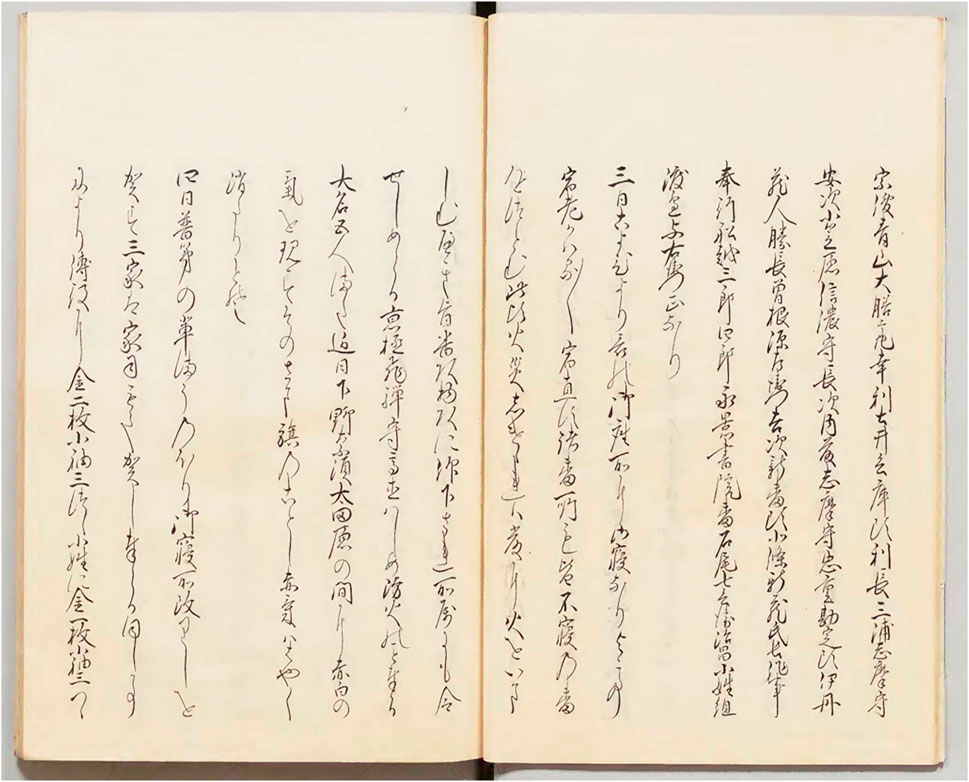
FIGURE 1. Candidate auroral record in the original manuscript of Genyu-in dono Gojikki (J01), reproduced from the manuscript in the National Archives of Japan (MS Special 075-0001–0193, v. 5, f. 10a).
On Joo 2nd year, 2nd month, 3rd day (1653 March 2), … recently, red and white vapours appeared between Nasu and Otawara in Shimotsuke. They were like flags. It is said that the red vapour vanished earlier. (Genyu-in dono Gojikki, v. 5, f. 10a).
On Shùnzhì 10th year, 2nd month, 3rd day (1653 March 2), during night, fiery lights illuminated the heaven in four directions. After a while, they became a blue wisp. (YCZ, v. 18, f. 10a).
Since Matsushita’s study (1956), the subject of this report was interpreted as one of the low-latitude aurorae observed in Japan on 2 March 1653, and this interpretation has been followed in the scientific community (Osaki, 1994; Willis and Stephenson, 2000; Nakazawa et al., 2004; Isobe et al., 2019). This record has been associated with the Chinese record of the same date to confirm the candidate auroral observations at Nasu (N37°01′, E140°07′), Otawara (N36°52′, E140°01′), and Cáoxiàn (N34°59′, E115°32′), as shown in Figure 2. Following the archaeomagnetic field model GUFM1, we have computed the magnetic latitudes (MLATs) of the candidate auroral observations as 29.7° MLAT, 29.9° MLAT, and 28.4° MLAT, respectively.
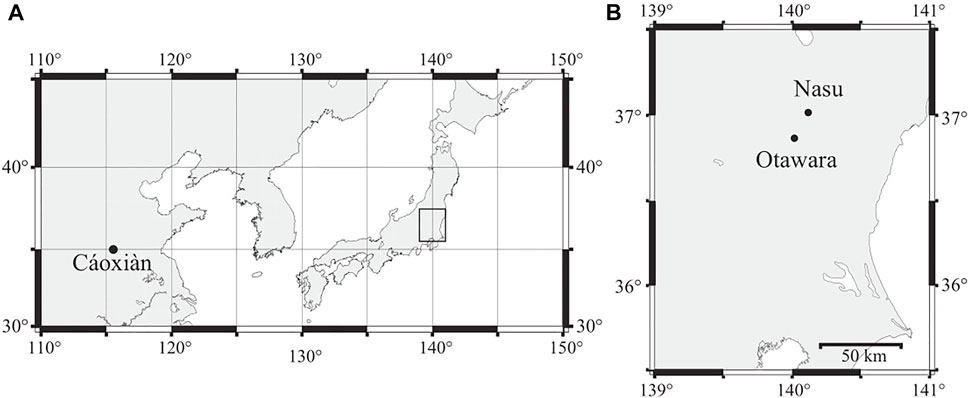
FIGURE 2. Observational sites of candidate aurorae associated with the extreme space weather event in March 1653. (B) shows a zoomed in view of the demarcated rectangle in (A).
In these studies, “recently” in TJ has been interpreted as 2 March 1653, namely the record entry date; however, this term admittedly involves some chronological ambiguity. Following our investigation on the record provenance for this entry in TJ, we have revealed that the date actually referred to Joo period, 1st year, 12th month (31 December 1652–28 January 1653). According to Komiya (2000), Sankeki is one of the original materials of TJ, and the source of Genyu-in dono Gojikki in TJ in 1653/1654 (Joo period 2nd year) relied on Sankeki. Here, we have consulted the original manuscript from the National Archives of Japan, and we translated this record as follows:
In the 12th month, red flags and white flags were hoisted in a field between Nasu and Otawara in Shimotsuke. It is said that the red flag vanished earlier. (Sankeki, v. 1, ff. 23b-24a).
This record is similar to that described in TJ, except for some minor details. First, the reddish and whitish vapours are described as reddish and whitish flags here. Second, this record dated the phenomenon to be in the “12th month” instead of “recently” in TJ (Figure 3). This confirms that this record was most probably not an observation on 2 March 1653, but a recollection on this date of previous hearsays. This event is chronologically located in the 12th month of the previous year of the entry date, namely Joo 1st year 12th month, which ranges from 31 December 1652 to 28 January 1653. Therefore, this report requires the revision of the observational date of the said candidate aurora from 2 March 1653 to within the period of 31 December 1652–28 January 1653.
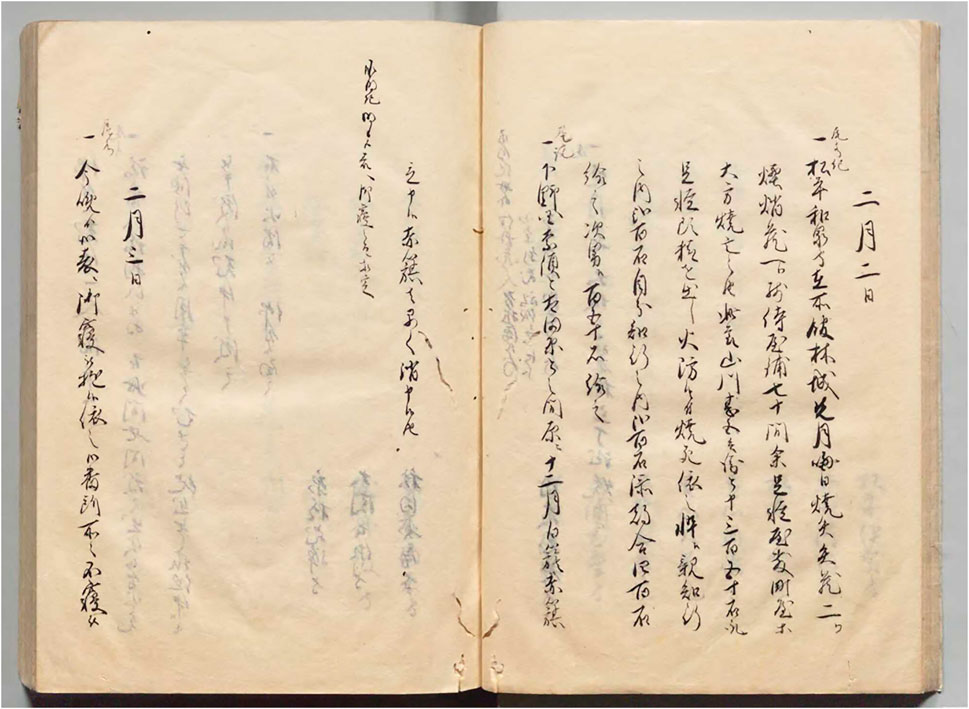
FIGURE 3. Candidate auroral record in the original manuscript of Sankeki (J03), reproduced from the manuscript in the National Archives of Japan (MS 165-0062–0001, v. 1, ff. 23b-24a).
This date range is further confirmed with the parallel records in Sho Tomegaki (hereafter ST) and Ohshuku Zakki (hereafter OZ), which read as follows:
In the same year (Joo 2nd) second month, it was rumoured that last year, the 12th month, white flags and red flags were somehow hoisted in a field between Nasu and Otawara in Shimotsuke. It is said that the red flag vanished earlier. (ST, v. 1, f. 3b).
In the same year (Joo 2nd) second month, it was rumoured: last year, the 12th month, white flags and red flags were somehow hoisted in a field between Nasu and Otawara in Shimotsuke. It is said that the red flag vanished earlier. (OZ, v. 79, f. 2b).
These records also dated the candidate aurora to be in the “12th month,” as shown in Figures 4, 5. OZ (J05) had been written under Norimura Komai (1766–1846) since 1815. Figure 5 shows J05, which was adopted from MS 238-1 (v. 79, f. 2b) of the National Diet Library of Japan. The author of ST is unknown, and OZ (J05) is an essay by Norimura Komai. A part of OZ, including the auroral descriptions, have been transcribed by an online crowdsourcing platform ‘Minna de Honkoku’ (Hashimoto and Kano, 2018). Notably, these records explicitly clarify that the candidate aurora appeared ‘the previous year’, but its description was not explicitly clarified in Sankeki (Figure 3). Their chronological order indicates that OZ owed this record to ST, whereas it is not certain if the candidate auroral records in Sankeki relied on these manuscripts.
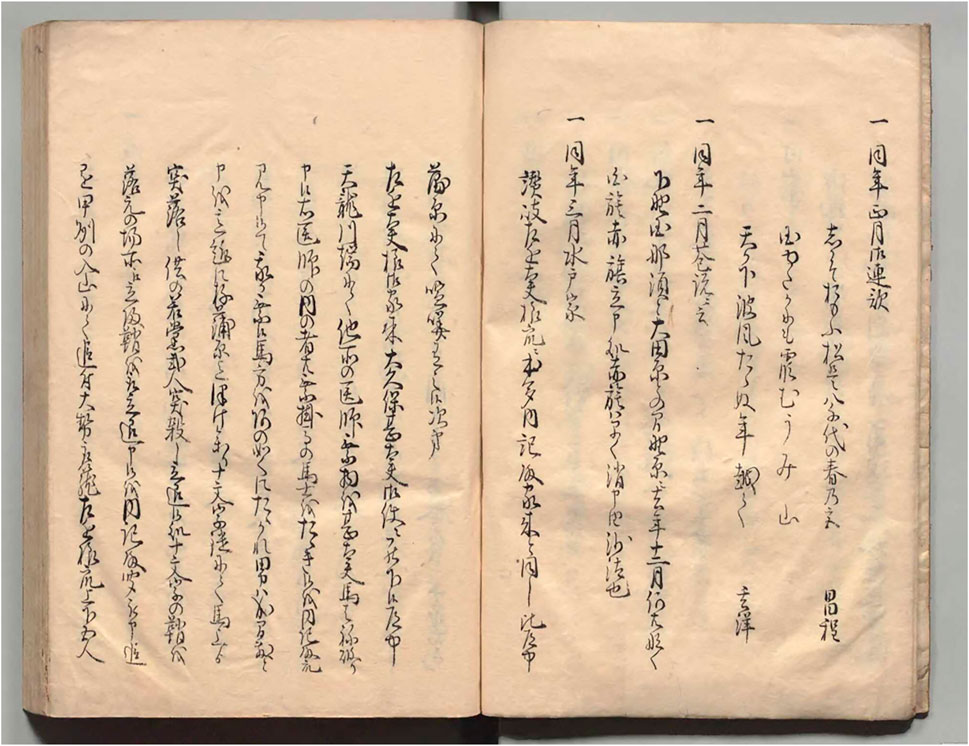
FIGURE 4. Candidate auroral record in the original manuscript of Sho Tomegaki (ST:J04), reproduced from the manuscript in the National Archives of Japan (MS 158-0515-0007, v. 1, f. 3b).
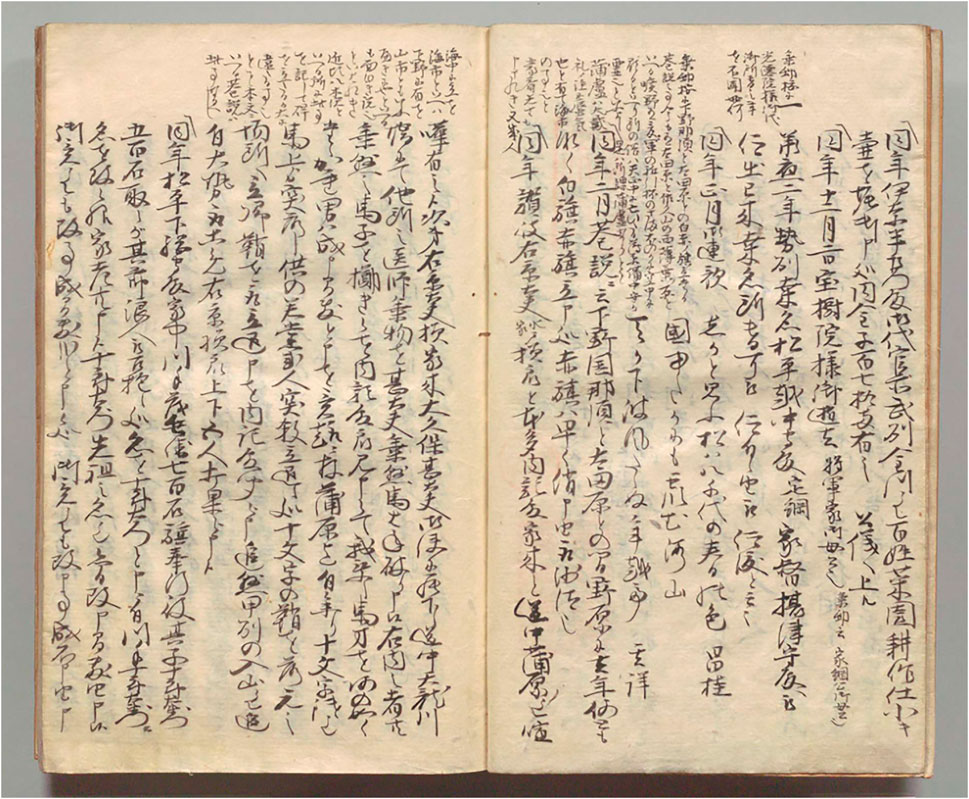
FIGURE 5. Candidate auroral record in the original manuscript of Ohshuku Zakki (OZ:J05), reproduced from the manuscript in the National Diet Library of Japan (MS 238-1, v. 79, f. 2b).
Source Documents for the September 1672 Storms
Honcho Nendaiki (本朝年代記, v. 5, f. 42b: hereafter HN) and Píngwàngzhì (平望志, v.13, f.6b: hereafter PZ) have been associated with the quasi-simultaneous 1672 candidate auroral records in Japan and China in previous studies (Osaki, 1994; Nakazawa et al., 2004); however, this has been subjected to criticism by Isobe et al. (2019). Here, we have consulted the original manuscript of HN from Ochanomizu University (Figure 6) and translated these records from the original source documents:
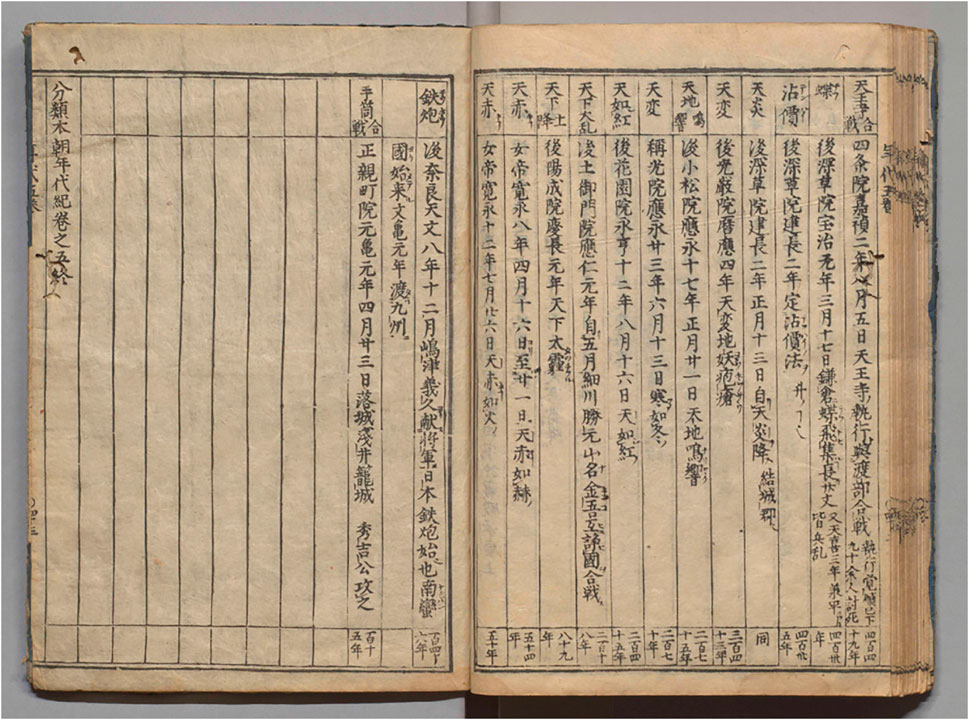
FIGURE 6. Candidate auroral record in the original manuscript of Honcho Nendaiki (HN:J06), reproduced from the manuscript in Ochanomizu University (MS D11/633/5, v. 5, f. 42b).
On Kāngxī 11th year 8th month 1st day (21 September 1672), during night, crimson vapour filled the heaven like fiery sand. (PZ, v.13, f.6b).
On Kan’ei 12th 7th month 26th day (7 September 1635), the heaven was red. (HN, v. 5, f. 42b).
These candidate auroral records locate the observational sites at Kyoto (N35°01′, E135°46′) and Píngwàng (N30°59′, E120°38′). Following the archaeomagnetic field model GUFM1, we have computed their magnetic latitudes (MLATs) as 29.7° MLAT and 28.4° MLAT, respectively. However, as commented by Isobe et al. (2019), the Japanese candidate auroral record was misdated as 17 September 1672 in previous studies (Osaki, 1994; Nakazawa et al., 2004), and the actual record is dated on 7 September 1635. Among the existing scientific literature, the Japanese report of the 1672 candidate aurora was first proposed in Osaki (1994), and this may be because the word Kan’ei (寛永) was misread as Kanbun (寛文), as explained in Isobe et al. (2019). This is probably because they are sharing the same Chinese character in their first characters. This mistake has been carried over to Nakazawa et al. (2004) as well.
Our archival investigation has attributed further credibility to this interpretation using independent contemporary records. Figure 7 shows a folio of Kunshin Genkoroku, which reads: “On Kan’ei 12th 7th month 26th day (7 September 1635), the entire heaven was red. Its brightness was like a fire” (Kunshin Genkoroku, v. 7, f. 22b). Here, we find more details than those in HN, such as the spatial coverage of the whole sky and the brightness being compared with a fire. This record robustly confirms the date given in HN and leaves little doubt on the chronological misinterpretation in Osaki (1994) and Nakazawa et al. (2004).
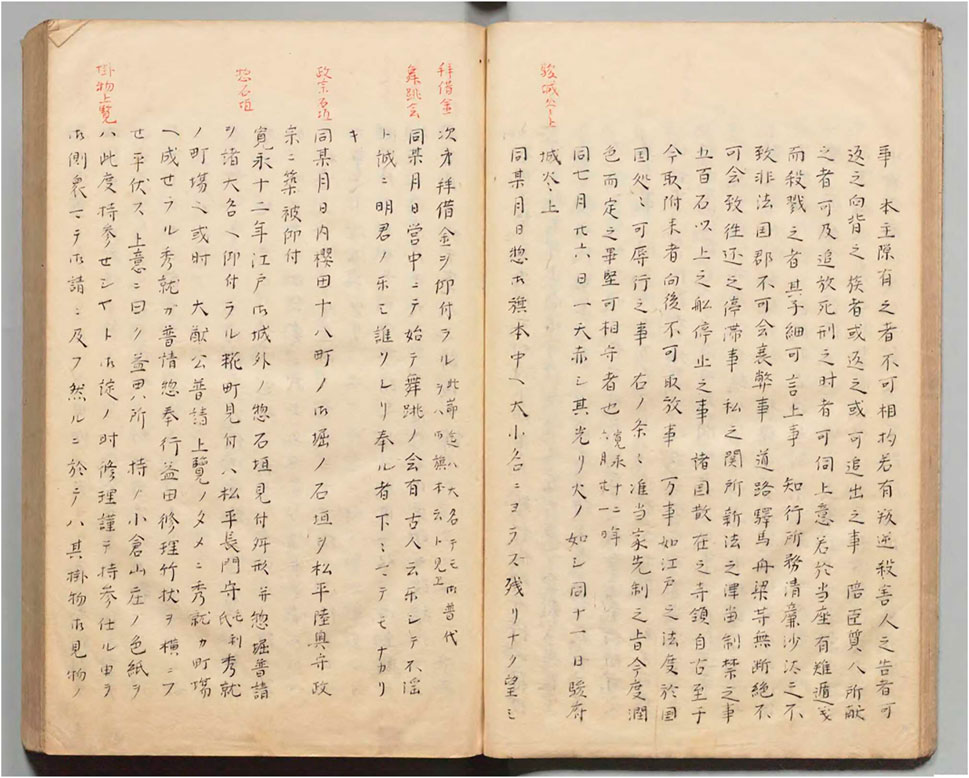
FIGURE 7. Candidate auroral record in the original manuscript of Kunshin Genkoroku (J07), reproduced from the manuscript in the National Archives of Japan (MS 158-0515-0007, v. 7, f. 22b).
Summary and Discussions
In this study, we have philologically analysed two clusters of the East Asian candidate auroral records from March 1653 and September 1672, which have been associated with simultaneous and consecutive auroral observations (Willis and Stephenson, 2000; Nakazawa et al., 2004). The former has been particularly considered as “virtually incontrovertible evidence” of auroral activity during the MM (Willis and Stephenson, 2000), and has been tentatively associated with a possible filament eruption (Isobe et al., 2019). However, our philological analyses have revealed dating problems in the Japanese records of these candidate aurorae.
For the March 1653 event, the Japanese record was derived from TJ (Figure 1) and dated as 2 March (Joo 2nd year 2nd month 3rd day); it was assumed that the “recent” celestial phenomenon occurred on the date the record was created. However, we investigated Sankeki, which is the original source for TJ in this year, and we revised the event date to the period 31 December 1652–28 January 1653. This revision has been supported by two contemporary records: ST and OZ (Figures 4, 5).
Likewise, for the September 1672 event, the original date was previously subjected to criticism by Isobe et al. (2019). We have confirmed their criticism with further archival evidence (Figure 6). We have also reinforced the revised date of 7 September 1635 (instead of 21 September 1672) with further contemporary records (Figure 7). As a result, we consider these records do not indicate a genuine aurora in September 1672 but a probable candidate aurora in September 1635.
Therefore, our study challenges the evidence supporting simultaneous observations in Japan and China, thereby, challenging the “virtually incontrovertible evidence” of auroral activity during the MM (Willis and Stephenson, 2000; Isobe et al., 2019). Our conservative interpretation is consistent with the known datasets for the contemporary sunspot group number (Vaquero et al., 2016), as these datasets locate the closest active days (with sunspots) for the alleged (quasi-)simultaneous auroral candidates on 2 March 1653 and 17 September 1672 only more than almost a month apart: on 5 February 1653 and 18 October 1672 (Figure 8). This means that the Sun was at least not quite active, while we certainly need to be extra cautious on the data scarcity and the contamination of ghost spotless days (Vaquero et al., 2016; Hayakawa et al., 2021c; Hayakawa et al., 2021d). This is fully contrasted with the simultaneous candidate auroral records in June 1680, which has been coupled with a distinct sunspot group at its chronological proximity (Hayakawa et al., 2021a).
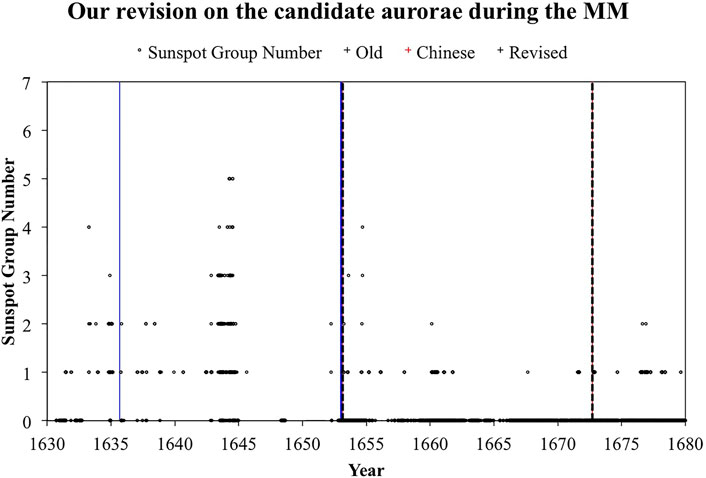
FIGURE 8. Our revision on the candidate aurorae in March 1653 and September 1672, contextualised with the daily sunspot group number of the contemporary individual observers (Vaquero et al., 2016).
However, their independent descriptions do not seriously contradict auroral interpretations, especially for the datable Chinese records. The reddish and fiery colourations are consistent with the typical low-latitude aurora, which is related to the type A aurora (Chamberlain, 1961, pp.124–125), and stable auroral red arcs (Rees, 1961; Kozyra et al., 1997), where low-energy electrons excite atomic oxygen in the upper atmosphere. The 1653 event may be also associated with the “blue wisp,” which refers to bluish emissions of molecular nitrogen ions, known as the sunlit aurorae (Hunten, 2003), although it is difficult to draw a definite conclusion since the observation time is unknown. These reports are confirmed as nighttime observations, owing to the observed colouration and significant spatial extents. There is a possibility that energetic neutral atoms originate from the storm-time ring current and result in bluish emission from molecular nitrogen ions (Tinsley et al., 1986). However, it is extremely difficult to associate these phenomena with atmospheric optics because nighttime atmospheric optics have a limited spatial extent and virtually imperceptible colourations when observed with the human eye (Minnaert, 1993, pp. 207–232).
Overall, these case studies have confirmed that the East Asian auroral evidence during the MM are no longer “virtually incontrovertible,” but still represent possible stray auroral activity in this period. This insight favours the significantly reduced space-weather activity during the MM (Silverman, 1992; Usoskin et al., 2015; Vaquero and Trigo, 2015; Hayakawa et al., 2021a), rather than persistent moderate space weather activity during that time (Schröder, 1992; Zolotova and Ponyavin, 2016). The abovementioned case studies have also emphasised the importance of philological case studies for candidate aurorae during the MM, which has been highlighted in previous studies (Usoskin et al., 2017; Hayakawa et al., 2021a). Further critical investigations on the candidate auroral records during the MM are required to robustly reconstruct the space weather variability at that time.
Data Availability Statement
The original contributions presented in the study are included in the article/Supplementary Material, further inquiries can be directed to the corresponding author.
Author Contributions
This research was performed with cooperation of the authors: KH surveyed historical records and made philological contributions. HH interpreted these records and arranged their information. YE made contributions on the interpretation and analysis of the auroras, supervising this study. All authors read and approved the final manuscript.
Funding
This work was financially supported in part by JSPS Grant-in- Aids JP20K22367, JP20K20918, JP20H05643, and JP21K13957, JSPS Overseas Challenge Program for Young Researchers, and the ISEE director’s leadership fund for FY2021 and Young Leader Cultivation (YLC) program of Nagoya University.
Conflict of Interest
The authors declare that the research was conducted in the absence of any commercial or financial relationships that could be construed as a potential conflict of interest.
Publisher’s Note
All claims expressed in this article are solely those of the authors and do not necessarily represent those of their affiliated organizations, or those of the publisher, the editors and the reviewers. Any product that may be evaluated in this article, or claim that may be made by its manufacturer, is not guaranteed or endorsed by the publisher.
Acknowledgments
HH has benefited from discussions within the ISSI International Team #510 (SEESUP Solar Extreme Events: Setting Up a Paradigm) and ISWAT-COSPAR S1-01 and S1-02 teams. The free GMT software (Wessel and Smith, 1991) has been used for Figure 2. We thank Ochanomizu University for permission to reproduce Figure 6.
Supplementary Material
The Supplementary Material for this article can be found online at: https://www.frontiersin.org/articles/10.3389/fspas.2022.832618/full#supplementary-material
References
Arlt, R., and Vaquero, J. M. (2020). Historical Sunspot Records. Living Rev. Sol. Phys. 17, 1. doi:10.1007/s41116-020-0023-y
Brehm, N., Bayliss, A., Christl, M., Synal, H.-A., Adolphi, F., Beer, J., et al. (2021). Eleven-Year Solar Cycles over the Last Millennium Revealed by Radiocarbon in Tree Rings. Nat. Geosci. 14, 10–15. doi:10.1038/s41561-020-00674-0
Carrasco, V. M. S., Hayakawa, H., Kuroyanagi, C., Gallego, M. C., and Vaquero, J. M. (2021). Strong Evidence of Low Levels of Solar Activity during the Maunder Minimum. MNRAS 504, 5199–5204. doi:10.1093/mnras/stab1155
Chamberlain, J. W. (1961). Physics of the Aurora and Airglow. New York: Academic Press. doi:10.1029/SP041
Hashimoto, Y., and Kano, Y. (2018). “The Role of Academic Institutions in Supporting Citizen Science: A Case of Minna de Honkoku,” in 2018 7th International Congress on Advanced Applied Informatics (IIAI-AAI), Yonago, Japan, 8-13 July 2018, 454–457. doi:10.1109/IIAI-AAI.2018.00097
Hayakawa, H., Besser, B. P., Iju, T., Arlt, R., Uneme, S., Imada, S., et al. (2020a). Thaddäus Derfflinger's Sunspot Observations during 1802-1824: A Primary Reference to Understand the Dalton Minimum. ApJ 890, 98. doi:10.3847/1538-4357/ab65c9
Hayakawa, H., Lockwood, M., Owens, M. J., Sôma, M., Besser, B. P., and van Driel-Gesztelyi, L. (2021b). Graphical Evidence for the Solar Coronal Structure during the Maunder Minimum: Comparative Study of the Total Eclipse Drawings in 1706 and 1715. J. Space Weather Space Clim. 11, 1. doi:10.1051/swsc/2020035
Hayakawa, H., Owens, M. J., Lockwood, M., and Sôma, M. (2020b). The Solar corona during the Total Eclipse on 1806 June 16: Graphical Evidence of the Coronal Structure during the Dalton Minimum. ApJ 900, 114. doi:10.3847/1538-4357/ab9807
Hayakawa, H., Ribeiro, P., Vaquero, J. M., Gallego, M. C., Knipp, D. J., Mekhaldi, F., et al. (2020c). The Extreme Space Weather Event in 1903 October/November: An Outburst from the Quiet Sun. ApJ 897, L10. doi:10.3847/2041-8213/ab6a18
Hayakawa, H., Schlegel, K., Besser, B. P., and Ebihara, Y. (2021a). Candidate Auroral Observations Indicating a Major Solar-Terrestrial Storm in 1680: Implication for Space Weather Events during the Maunder Minimum. ApJ 909, 29. doi:10.3847/1538-4357/abb3c2
Hayakawa, H., Kuroyanagi, C., Carrasco, V. M., Uneme, S., Besser, B. P., and Soma, M. (2021c). Sunspot Observations at the Eimmart Observatory and in its Neighborhood During the Late Maunder Minimum (1681‐1718). ApJ 909, 166. doi:10.3847/1538-4357/abd949
Hayakawa, H., Iju, T., Uneme, S., Besser, B. P., Kosaka, S., and Imada, S. (2021d). Reanalyses of the Sunspot Observations of Fogelius and Siverus: Two ‘Long-Term’ Observers During the Maunder Minimum. MNRAS 506, 650–658. doi:10.1093/mnras/staa2965
Hoyt, D. V., and Schatten, K. H. (1998). The Group Sunspot Numbers: A New Solar Activity Reconstruction. Sol. Phys. 179, 189–219. doi:10.1023/A:1005007527816
Hunten, D. M. (2003). Sunlit Aurora and the N2+ Ion: A Personal Perspective. Planet. Space Sci. 51, 887–890. doi:10.1016/S0032-0633(03)00079-5
Isobe, H., Ebihara, Y., Kawamura, A. D., Tamazawa, H., and Hayakawa, H. (2019). Intense Geomagnetic Storm during Maunder Minimum Possibly by a Quiescent Filament Eruption. ApJ 887, 7. doi:10.3847/1538-4357/ab107e
Kilpua, E. K. J., Olspert, N., Grigorievskiy, A., Käpylä, M. J., Tanskanen, E. I., Miyahara, H., et al. (2015). Statistical Study of Strong and Extreme Geomagnetic Disturbances and Solar Cycle Characteristics. ApJ 806, 272. doi:10.1088/0004-637X/806/2/272
Komiya, K. (2000). Records of the Shogunate in the Early Years of Ietsuna's Reign (4th Month Keian 4 Year to Manji 3 year). Tokyo Daigaku Shiryo Hensan-jo Annu. Rep. 10, 39–58. [in Japanese].
Kozyra, J. U., Nagy, A. F., and Slater, D. W. (1997). High-Altitude Energy Source(s) for Stable Auroral Red Arcs. Rev. Geophys. 35, 155–190. doi:10.1029/96RG03194
Lefèvre, L., Vennerstrøm, S., Dumbović, M., Vršnak, B., Sudar, D., Arlt, R., et al. (2016). Detailed Analysis of Solar Data Related to Historical Extreme Geomagnetic Storms: 1868 - 2010. Sol. Phys. 291, 1483–1531. doi:10.1007/s11207-016-0892-3
Matsushita, S. (1956). Ancient Aurorae Seen in Japan. J. Geophys. Res. 61, 297–302. doi:10.1029/jz061i002p00297-02
Muñoz-Jaramillo, A., and Vaquero, J. M. (2019). Visualization of the Challenges and Limitations of the Long-Term sunspot Number Record. Nat. Astron. 3, 205–211. doi:10.1038/s41550-018-0638-2
Nakazawa, Y., Okada, T., and Shiokawa, K. (2004). Understanding the "SEKKI" Phenomena in Japanese Historical Literatures Based on the Modern Science of Low-Latitude aurora. Earth Planet. Sp 56, e41–e44. doi:10.1186/BF03353323
Owens, M. J., and Lockwood, M. (2012). Cyclic Loss of Open Solar Flux since 1868: The Link to Heliospheric Current Sheet Tilt and Implications for the Maunder Minimum. J. Geophys. Res. Space Phys. 117, A04102. doi:10.1029/2011JA017193
Owens, M. J., Lockwood, M., Barnard, L. A., Scott, C. J., Haines, C., and Macneil, A. (2021). Extreme Space-Weather Events and the Solar Cycle. Sol. Phys. 296, 82. doi:10.1007/s11207-021-01831-3
Rees, M. H. (1961). Excitation of High Altitude Red Auroral Arcs. Planet. Space Sci. 8, 59–67. doi:10.1016/0032-0633(61)90156-8
Réthly, A., and Berkes, Z. (1963). Nordlichtbeobachtungen in Ungarn. Budapest: Verlag der Ungarischen Akademie der Wissenschaften. [in German].
Riley, P., Lionello, R., Linker, J. A., Cliver, E., Balogh, A., Beer, J., et al. (2015). Inferring the Structure of the Solar Corona and Inner Heliosphere during the Maunder Minimum Using Global Thermodynamic Magnetohydrodynamic Simulations. ApJ 802, 105. doi:10.1088/0004-637X/802/2/105
Schröder, W. (1992). On the Existence of the 11-Year Cycle in Solar and Auroral Activity before and during the So-Called Maunder Minimum. J. Geomagn. Geoelec 44, 119–128. doi:10.5636/jgg.44.119
Silverman, S. M., and Hayakawa, H. (2021). The Dalton Minimum and John Dalton's Auroral Observations. J. Space Weather Space Clim. 11, 17. doi:10.1051/swsc/2020082
Silverman, S. M. (1992). Secular Variation of the Aurora for the Past 500 Years. Rev. Geophys. 30, 333–351. doi:10.1029/92RG01571
Silverman, S. M. (1993). Is the Maunder Minimum Real? Eos, Trans. Am. Geophys. Union 74, 450–461. doi:10.1029/93EO00513
Stangl, M., and Foelsche, U. (2021). Aurora Observations from the Principality of Transylvania from the 16th to the 18th Century CE. Sol. Phys. 296, 78. doi:10.1007/s11207-021-01811-7
Svalgaard, L., and Schatten, K. H. (2016). Reconstruction of the sunspot Group Number: the Backbone Method. Sol. Phys. 291, 2653–2684. doi:10.1007/s11207-015-0815-8
Tinsley, B. A., Rohrbaugh, R., Rassoul, H., Sahai, Y., Teixeira, N. R., and Slater, D. (1986). Low-latitude Aurorae and Storm Time Current Systems. J. Geophys. Res. 91, 11257–11269. doi:10.1029/JA091iA10p11257
Tsurutani, B. T., Echer, E., and Gonzalez, W. D. (2011). The Solar and Interplanetary Causes of the Recent Minimum in Geomagnetic Activity (MGA23): A Combination of Midlatitude Small Coronal Holes, Low IMF B Z Variances, Low Solar Wind Speeds and Low Solar Magnetic Fields. Ann. Geophys. 29, 839–849. doi:10.5194/angeo-29-839-2011
Usoskin, I. G., Arlt, R., Asvestari, E., Hawkins, E., Käpylä, M., Kovaltsov, G. A., et al. (2015). The Maunder Minimum (1645-1715) Was Indeed a Grand Minimum: A Reassessment of Multiple Datasets. A&A 581, A95. doi:10.1051/0004-6361/201526652
Usoskin, I. G., Hulot, G., Gallet, Y., Roth, R., Licht, A., Joos, F., et al. (2014). Evidence for Distinct Modes of Solar Activity. A&A 562, L10. doi:10.1051/0004-6361/201423391
Usoskin, I. G., Kovaltsov, G. A., Mishina, L. N., Sokoloff, D. D., and Vaquero, J. (2017). An Optical Atmospheric Phenomenon Observed in 1670 Over the City of Astrakhan Was Not a Mid-Latitude aurora. Sol. Phys. 292, 15. doi:10.1007/s11207-016-1035-6
Usoskin, I. G., Solanki, S. K., Krivova, N. A., Hofer, B., Kovaltsov, G. A., Wacker, L., et al. (2021). Solar Cyclic Activity over the Last Millennium Reconstructed from Annual 14C Data. A&A 649, A141. doi:10.1051/0004-6361/202140711
Vaquero, J. M., Svalgaard, L., Carrasco, V. M. S., Clette, F., Lefèvre, L., Gallego, M. C., et al. (2016). A Revised Collection of Sunspot Group Numbers. Sol. Phys. 291, 3061–3074. doi:10.1007/s11207-016-0982-2
Vaquero, J. M., and Trigo, R. M. (2015). Redefining the Limit Dates for the Maunder Minimum. New Astron. 34, 120–122. doi:10.1016/j.newast.2014.06.002
Vázquez, M., Vaquero, J. M., Gallego, M. C., Roca Cortés, T., and Pallé, P. L. (2016). Long-Term Trends and Gleissberg Cycles in Aurora Borealis Records (1600 - 2015). Sol. Phys. 291, 613–642. doi:10.1007/s11207-016-0849-6
Wang, G., Yao, S., Yu, Y., Wei, D., Di, F., and Bao, X. (2021a). Aurora Sightings Observed in Chinese History Caused by CIRs or Great-Storm CMEs. Astrophys. J. 908, 187. doi:10.3847/1538-4357/abd0fe
Wang, Y., Chen, S., Xu, K., Yan, L., Yue, X., and He, F. (2021b). Ancient Auroral Records Compiled from Korean Historical Books. J. Geophys. Res. Space Phys. 126, e2020JA028763–. doi:10.1029/2020JA028763
Wessel, P., and Smith, W. H. F. (1991). Free Software Helps Map and Display Data. EOS Trans. Am. Geophys. Union 72, 441. doi:10.1029/90EO00319
Willis, D. M., and Stephenson, F. R. (2000). Simultaneous Auroral Observations Described in the Historical Records of China, Japan and Korea from Ancient Times to AD 1700. Ann. Geophys. 18, 1–10. doi:10.1007/s00585-000-0001-6
Zolotova, N. V., and Ponyavin, D. I. (2016). How Deep Was the Maunder Minimum? Sol. Phys. 291, 2869–2890. doi:10.1007/s11207-016-0908-z
Keywords: maunder minimum, solar activity, aurorae, east asian historical records, philological analyses
Citation: Hattori K, Hayakawa H and Ebihara Y (2022) Great “Space Weather Events” in March 1653 and September 1672 Were Not Supported With Simultaneous/Clustering Auroral Observations During the Maunder Minimum. Front. Astron. Space Sci. 9:832618. doi: 10.3389/fspas.2022.832618
Received: 10 December 2021; Accepted: 18 February 2022;
Published: 16 March 2022.
Edited by:
Fadil Inceoglu, GFZ German Research Centre for Geosciences, GermanyReviewed by:
Gennady Kovaltsov, Ioffe Institute (RAS), RussiaMartin Stangl, Austrian Science Fund (FWF), Austria
Copyright © 2022 Hattori, Hayakawa and Ebihara. This is an open-access article distributed under the terms of the Creative Commons Attribution License (CC BY). The use, distribution or reproduction in other forums is permitted, provided the original author(s) and the copyright owner(s) are credited and that the original publication in this journal is cited, in accordance with accepted academic practice. No use, distribution or reproduction is permitted which does not comply with these terms.
*Correspondence: Kentaro Hattori, aGF0dG9yaUBrdWVwcy5reW90by11LmFjLmpw
 Kentaro Hattori
Kentaro Hattori Hisashi Hayakawa2,3,4
Hisashi Hayakawa2,3,4 Yusuke Ebihara
Yusuke Ebihara